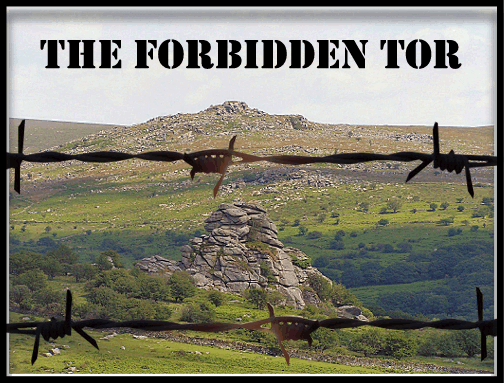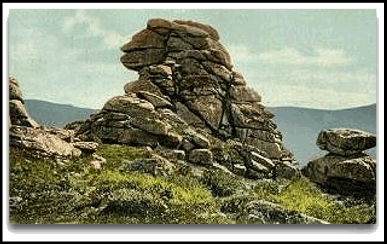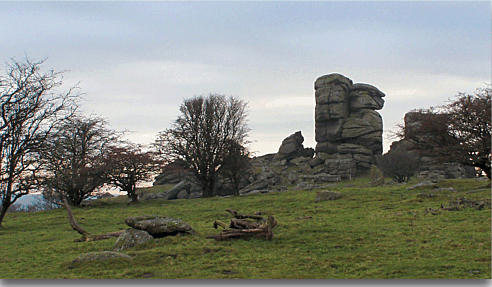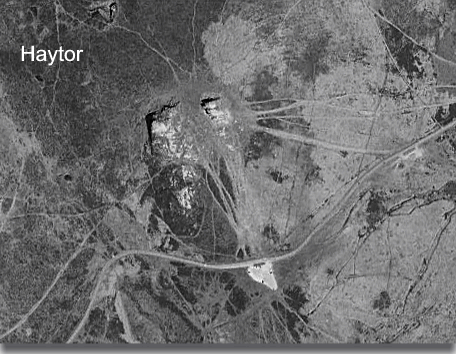
In May 2003 it was announced that the owner of the land on which Vixen tor stands had closed all access to the famous landmark. Although for the past 30 years the land was held in private ownership there had always been an access agreement. The new owner, Mrs Alford, said there was no legal public right of access to the site and that she has been advised by her insurance company to close it as she could be liable if anyone injured themselves while walking or climbing. This very soon had various representative bodies such as The Ramblers Association and The British Mountaineering Council up in arms and various campaigns were launched.
Over the next two years various protests and ‘mass trespasses’ were organised to bring the issue to the media’s attention. The first official protest was organised by the British Mountaineering Council and it took place on January 1st 2004 where a ‘mass trespass’ of 20 people took place.
In June 2004 a District Judge at Plymouth Magistrates’ Court found that the landowner had failed to obtain a consent under the Regulations before engaging in scrub clearance and the application of fertiliser (calcified seaweed and farmyard manure) on four fields of unimproved grassland around Vixen Tor. The landowner was fined £1,000 and £5,000 costs. DEFRA will now move towards ensuring the reinstatement of this land. In May 2005 this then went to the High Court of Appeal where two senior judges overturned the ruling.
In January 2005 a public inquiry in fact found it to be farmland on the basis of the grass percentage of the total flora. The inspectors did note that it was a very close decision but it meant that as it was classed as farmland it came outside the open access land and was allowed to be closed. The Ramblers Association objected to the appeal by Mrs Mary Alford and her son Daniel and were joined by the Open Spaces Society, the Dartmoor Preservation Association, the British Mountaineering Council, and the Countryside Agency, which were responsible for mapping the land. But despite this finding it was decreed that the landowner still had the right to deny access to the tor.
Mrs Alford was also the subject of an assault in May 2005. A spokesman for Devon and Cornwall Police confirmed that officers were called to the tor and a result, a 24-year-old man from Tavistock received a caution for common assault when he had clashed with Mrs Alford, who fell off a wall during a demonstration against the inspector’s decision
In September 2005 another ‘mass trespass’ of 80 walkers and climbers took place. Some of the latter climbed the tor and unfurled a banner which read, Vixen Tor for all to enjoy”. It was then alleged by members of the British Mountaineering Council that during a climb one of the ropes were cut and one man was assaulted. The police were called and it was requested that charges were brought, these were later dropped.

In January 2006 yet another ‘mass trespass’ was organised for New Year’s day to continue the pressure for the land to be re-opened. This was none too successful as when the protesters arrived they found that the landowner was holding a clay pigeon shoot and barbeque and it was deemed too dangerous to proceed.
It then appears that Mrs Alford decided that for a one-off payment of £30,000, followed by an annual payment of £35,000 plus insurance and legal costs she would open the land under a ten year agreement. The Dartmoor National Park Authority had offered an annual payment of £1,500. It is interesting to see how this magical figure of £35,000 is reached, the landowners in return for an access licence expect the National Park to pay:
1) An annual payment of £30,000 for public access, this figure was arrived at by the following calculation:
Average number of visits per week = 198.5
Average number of visits per day = 28.3
Total visits per year = 10,325
Value per visit = £3.00
Total visit value per year = £30,978.
2) An annual payment of £2,500 to compensate for the disruption to the landowners farming business?
3) An annual management fee of £2,500 to cover the costs of such management practices as clearing litter. This charge is slightly puzzling as in the proposed conditions of the access licence there is a clause which prohibits, “creating rubbish/litter…,” so where is the litter going to come from?
4) A single payment of £30,000 to reimburse the land owner for cost incurred in connection with the previous public inquiry for the CROW act. Considering that the access agreement would be for 10 years this cost would equate to £3,000 per annum.
The actual total cost per annum (including the £3,000 for the single payment) actually would amount to £38,000 which brings the sum of the value per visit to £3.68 per head. To put this into a value for money perspective, one adult and a child could visit the nearby Dartmoor Prison Museum for £3.00 where there are numerous exhibits and items of interest not just a single tor. How long could you look at a tor or how long would it take to walk around a tor? Fair enough if you were rock climbing you would spent several hours on the tor in which case £3.68 does seem good value for money. Except there is a clause in the access agreement which states, “No damage to be done to the Tor …,” which would slightly curtail any climbing activities. Oh, and if you are walking your dog you will have to leave it at the gate as a further clause insists that, “animals are not permitted.” Ok, in cash terms obviously nobody would pay out physically to get access to Vixen tor but in the long run the money comes from somewhere and one of those sources is the British taxpayer which I know is a dying breed but rumour has it there are still a few unfortunates left.
A meeting of the Dartmoor National Park Authority was held on March 3rd 2006 where it concluded that there were two options remaining for the way ahead:
“(i) to conclude that the gulf in aspiration is so great that ‘meaningful progress’ has not been made, agreement is unlikely, and there is no justification for further talks;
(ii) to make the owners a higher and final offer that is both affordable and value for money, and determine that if this offer is not accepted the situation at (i) above applies; online source found at: 03 March 2006 Authority Meeting
Another mass protest was organised by the British Mountaineering Council on the 6th of May 2006 where around 50 people trespassed on the tor, once again there was no action taken. And so the saga continues, it is at this point that one loses any sympathy with the landowner whatsoever, this is sheer greed and totally unfounded. Previously it could have been argued that there are numerous other tors to climb and miles and miles of alternative moorland to ramble over and every Englishman’s home is his castle. But how on earth can anybody arrive at the sum of £3.68 to visit Vixen tor? I think if I was offered £1,500 to let people walk over my lawn I would be very tempted. This emotive subject strikes a different chord with a lot of people, personally I think it is a shame that people are denied access to a fine Bronze Age kistvaen that lies near the bottom of the tor. The last time I visited it was in danger of becoming an integral part of a log pile as can be seen below, naturally this picture was taken with a huge telephoto lens and I did not enter the ‘forbidden zone’:

A press announcement from the Devon County Council’s Public Rights of Way Committee was issued on the 3rd of March 2009 stating that the members had unanimously supported recommendations for a footpath across Vixen Tor. The modification order to amend the definitive map dictates that there is a footpath added that goes via the tor from the Whitchurch Path (No. 13) to the Sampford Spiney footpath (No. 5). This decision was taken on the evidence that a right of way to the tor had subsisted prior to Alford’s purchase of the land. Devon County Council will now make the modification order to amend the definitive map. Following this there is a six week objection period in which anyone can voice their objections. If any of these are not later withdrawn then an independent inspector will be appointed by the Planning Inspectorate who will then hold a local public inquiry. But before anyone packs their hamper and heads off to Vixen Tor for a picnic there are two points to consider. Firstly, until the modification order has been carried out the land remains private property. Secondly, Alford is still whinging on that there was never any public right of way on the land which means she is bound to object and everything goes back to another inquiry.
The start of 2011 still sees Vixen Tor out of bounds to the public, another enquiry was held in late December 2010 which was set to resolve the situation for once and all. Sadly after 2 days the meeting was abandoned due to the snow and will not be resumed until sometime in July 2011.
The long awaited inquiry has now taken place under the directorship of Mark Yates, with the same old song from Mrs Alford, namely that as far as she is concerned Vixen Tor has always been on private land. Apparently she has been regularly visiting the area since the age of 3 and claims that during this time she has never seen anyone around the tor. Various presentments have been made by members of The Ramblers Association and The Devon Ramblers stating that there was in fact a right of way to the tor until 2003. What needs to be proven is that the tor has been visited without interruption by the public over a period of twenty years. If this fact can be established then under the Highways Act of 1980 then a right of way can be ordered. The inspector will now examine all his evidence and then the matter lies before the Secretary of State who will eventually come to a conclusion. How much have all these various inquiries cost compared with what harm would be caused by giving public access to such a small piece of Dartmoor?
Well the final decision has been made and as far as the public goes it’s not good news, it was announced this week (September 2011) that the planning inspector has ruled that there was not enough evidence to prove a footpath had been used continuously for 20 years. Despite 59 people giving oral accounts of their visits to the tor in the 1970s, documents were found that suggested that between the statutory usage period from 1956 – 1976 there was a time it was closed. The planning Inspector, Mark Yates commented that: “Overall I accept that people have walked to Vixen Tor and used routes through the enclosure. However, I am not satisfied that, on balance, the evidence of public use of the order route, either in whole or part, presented to the inquiry is sufficient to demonstrate the dedication of this route at common law.” So, the end of a long and costly saga, Vixen Tor still remains ‘The Forbidden Tor’. Maybe it’s worth noting the following guidance by The Ramblers Association: ‘In most cases, trespass is a civil rather than a criminal matter. A landowner may use “reasonable force” to compel a trespasser to leave, but not more than is reasonably necessary. Unless injury to the property can be proven, a landowner could probably only recover nominal damages by suing for trespass. But of course you might have to meet the landowner’s legal costs. Thus a notice saying “Trespassers will be Prosecuted”, aimed for instance at keeping you off a private drive, is usually meaningless. Criminal prosecution could only arise if you trespass and damage proper.’ To gain access to the tor will involve climbing over a stone wall (so I am told) and it’s worth remembering that even dislodging a stone could count as criminal damage.
Not happy with having won her case, the landowner, Mrs Alford now finds it fit to announce: “We are pleased that the inspector, having seen all the evidence, agrees with us that there is no public access at Vixen Tor Farm. It has been a difficult period for me and my family and we have been put to considerable expense to prove what we believed all along. I question how much has this cost the local taxpayer? At a time when the council is cutting back on spending for all Devon communities it seems such a waste of taxpayers’ money when the council should have listened to locals and done their research more diligently“.
One thing, it was not the various inquiries that wasted taxpayers’ money that was spent in attempting to gain access to a part of Dartmoor that is rich in heritage, archaeological features and traditions. It was/is the selfish and unreasonable behaviour of the landowner in denying the public the chance to visit the tor with a very untypical (for Dartmoor) attitude of ‘Get off my land‘. Thankfully there are numerous landowners that want to share with the public the various Dartmoor treasures that they own.
Postscript. I came across an article today (09/11/2011) that proudly announced that a company called Bluesky provided ‘crucial evidence‘ in the Vixen Tor enquiry. ‘The company supplied the historic aerial photography complete with certificates of authentification from their Old Aerial Photos archive providing factual and unbiased evidence for further investigation by Air Photo Services, a company that offers specialist interpretation of aerial imagery, consultancy and expert witness services. Director Chris Cox commented, “Acting as an Expert Witness and working on behalf of my client, I was able to establish, using the historic images, that a footpath was not visible in the alleged place. I conducted comparative analysis on other visible paths in the area from the 1940s to the present day to support this claim,” (Directions Magazine, on-line source). Anybody who has walked Dartmoor will have at some followed a ‘footpath’ only to find it coming to an abrupt end, why? because it was a sheep track. I would love to know how on earth anyone can distinguish a ‘footpath’ as opposed to a sheep track from an aerial photograph? Below is an aerial photograph taken from Google Earth at an altitude of 6,043ft, are the tracks a footpath or sheep tracks?

The above track certainly follows a direct line so the argument could be that using this shows a visible path which when compared with the Vixen Tor aerial photograph (which shows no visible path) must mean there was no right of way was there when the picture was taken. Now click HERE for a wider view of the above photo. As you can see, the area shown on the aerial photo is in fact Pinswell which is to the west of Fur Tor which in turn is in the heart of north Dartmoor where no public footpaths exist. It could then be argued that a public footpath, if used regularly would appear wider than a sheep track, ok, below is an aerial photograph taken from Google Earth of Haytor which is one of the most visited spots on Dartmoor.

Here you can clearly see a veritable criss-cross of paths leading up and away from the tor but what were made by the tread of human feet and what were made by animal hooves? Clearly the wider ones are the result of people using the same path so if these were public footpaths (which they are not) it may be suggested they are distinguishable from sheep tracks. However, it must be remembered that the numbers of people visiting Dartmoor today are much greater than in 1940 so any public footpath would not be as well trod and therefore harder to differentiate. And this type of ‘evidence’ was deemed as ‘crucial’ in the enquiries decision?
 Legendary Dartmoor The many aspects past and present of Dartmoor
Legendary Dartmoor The many aspects past and present of Dartmoor

A thought – I thought people had visiting all prominent Tors doing letterboxing on Dartmoor since the 60’s? Vixen Tor would likey have had one, certainly by the 70’s. And there must be hundreds of maps around stamped with a letterbox stamp which would proove people went there lots of times I wonder?
Throughout the various enquiries numerous old maps, book extracts and letterboxing memorabilia etc was produced – all to no avail.
Sounds like corruption – someone with friends in the right places.
I would absolutely agree with that comment.
It’s me again. I see from other sites that this person, or someone owning the farm, is now running holiday lets, using the Tor as a marketing icon. The whole thing become clearer and clearer – their sole interest is in screwing as much money from it as they can, and the whole business of closing it was to ensure only paying access is available.
Given the blatant bias of the Government planning officer, and the inability of either the council or the national park authority to successfully overturn this injustice, I would like to remind Mrs Alford of a very profound truism. There are no pockets in a shroud. And may the money you gain from this scheme rot.
This doesn’t sound, was hoping to visit there today only to see no public access sprayed on the wall surrounding the tor and the gate padlocked, I was unaware that it was privately owned. Greedy people all they care is about money , should not of been able to buy the land